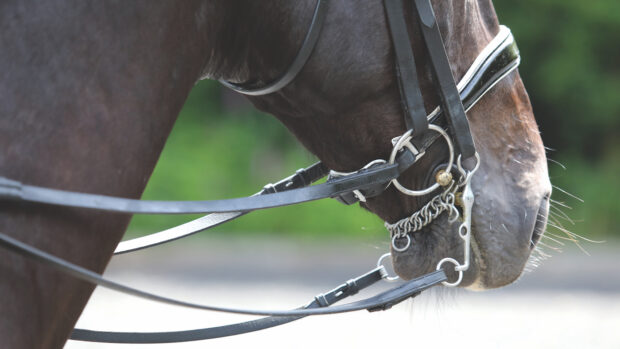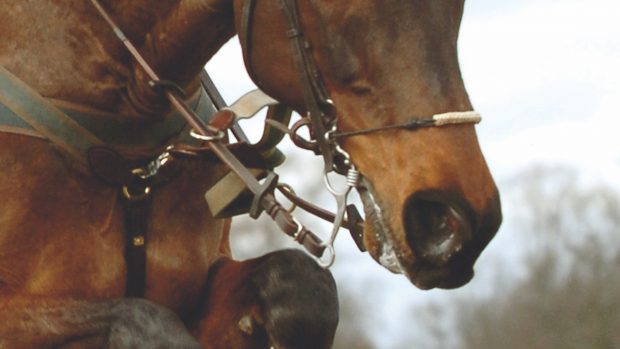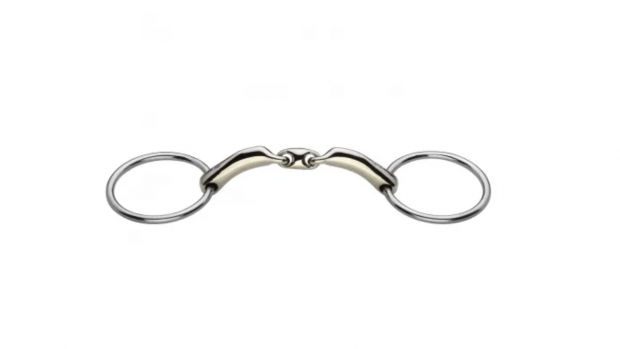Every horse is an individual, each with different mouth conformation, which is why there are many types of bit to suit all requirements and preferences.
How the horse’s mouth is conformed will influence whether he prefers a thin or thick bit, a certain type of action and mouthpiece. The thickness of his tongue, the way his jaw is set, and even his natural head carriage will all play a part. A strong horse does not necessarily need a stronger bit – a different type of bit, possibly combined with more training, may sort out any control issues.
The rider’s expertise also comes in to play, as well as the horse’s discipline. Fortunately there are hundreds of bits, with different thicknesses and permutations. It can be a minefield trying to work out which one would suit your horse best. Often it is a case of trial and error, as well as taking the advice of your trainer and an independent bitting expert, to find the perfect match.
Three main types of bit
Snaffles

This is the most common bit, but there is a wide range of options.
How it works: by placing pressure on the tongue, corners of the mouth and bars (spaces between the front and back teeth). There is very little poll or leverage action, although some of the different rings connecting to the cheekpieces can create a small amount.
Who is it for: snaffles tend to be fairly mild while still providing adequate communication between horse and rider. They are a common bit choice for young horses.
Snaffles are usually single jointed, a lozenge (double jointed) or French link. The eggbutt snaffle (pictured above) is particularly common, and known as a good all-round bit. Loose-ring snaffles are also common, but have a slightly different action to the eggbutt. Slightly less common is the straight-bar snaffle, which works on the tongue and bars. It is made more comfortable in the mullen-mouth (curved) or polymer versions that contour around the curves of the mouth. Some horses prefer the straight bar to the nutcracker action of a jointed snaffle.
There are a range of cheekpieces, such as D-rings, full-cheeks, loose-rings, “Wilkies” (loop ring) and hanging cheeks. Each one has a slightly different effect and control, which you will need to consider when selecting the right one for your horse.
Gags

Often the mouthpiece is the same as for the snaffle, but it is a much more severe bit, as the cheekpieces, rings or shanks apply pressure to more areas of the horse’s head.
How it works: it applies pressure to the lips and poll, encouraging the horse to lift his head and stop him from leaning on the bit, while the poll pressure discourages him from lifting his head too high.
There are three main types of gag, all used with a snaffle-type mouthpiece. They are designed to be used with two reins, one connected to the snaffle part, and the other to the ring below the bit to increase poll pressure:
- Dutch gag (pictured above): consists of three or four rings – the top one where the cheekpieces attach and three lower ones for various settings, with the lowest being the strongest.
- Running or Cheltenham gag: strips of leather or cord replace the cheekpieces and slide through the holes in the bit rings. The top part attaches to the headpiece of the bridle, while the bottom part fastens on to the bottom gag rein. Another set of reins attaches to the snaffle rings. People do use just a single gag rein, but this is a very strong set-up and gives no option of using the plain snaffle contact.
- American gag: this has shanks, which can be of varying lengths. The longer the shank, the greater the poll pressure. They can be used with two reins – it is easier for steering to have the snaffle rein as well. Some riders feel this is less severe than the other gags because the elevator action is more limited.
Who is it for: typically for horses that lean on the bit, are on the forehand or are strong pullers to give the rider more control. It has the potential to be very severe so should not be used by novice riders.
Curbs

These provide greater control compared to the snaffles.
How it works: by putting pressure on four areas, the tongue, corners of the mouth, bars and the chin groove. Some designs also give a small amount of poll action. Sometimes they have a port, which can apply pressure on the roof of the mouth if it is very large. Smaller ports offer added room for the tongue.
They are split into three categories:
- Pelham: a single mouthpiece – usually straight but can be jointed, which is more severe. It has shanks, which can be used with two reins. The bottom (curb) rein applies pressure on the poll and the curb groove as the shank moves backwards. Roundings can be used to connect the two rings, so that it can be used with one rein.
- Weymouth: works the same as the Pelham on the curb rein. This is the second bit in a double bridle (pictured above) and is combined with a bradoon (a neat snaffle designed specifically for use in a double bridle).
- Kimblewick: similar to the Pelham, but with a hanging D-ring. It has similar action to the Pelham, but due to the lack of shank and the fact that it is used with one rein, it is considered a milder option.
Who is it for: the double bridle is used in higher level dressage and showing, while Pelhams, with roundings, and Kimblewicks are popular options for children on strong ponies.
Hackamores

The most common bitless bridle, hackamores are essentially a noseband with a shank, which acts on pressure points on the nose, chin and poll – there is nothing in the horse’s mouth. Although there is no bit, it can be very severe in the wrong hands because of the amount of pressure it can exert. There are various varieties, such as German, English, flower and bosal.
How it works: the reins are attached to the shanks, which connect to the noseband and chinstrap. This puts pressure via the curb or chinstrap under the chin, the poll and the front of the nose.
Who is it for: a horse that has suffered a mouth injury or won’t accept a conventional bit. It is also often used by endurance riders as the horse can eat and drink more easily without a bit.
Whatever type of bit you use, it must be the appropriate size for your horse, correctly fitted and any sign of discomfort should be acted upon immediately.
You may also like read…

9 bits designed with young horses in mind

8 superb snaffle bits with a lozenge
Are you looking for a new, stylish snaffle bit that features a lozenge mouthpiece? If so look no further….

How to ride in a double bridle

Have you ever considered going to a bitting clinic to solve your problems?
Navigating the often bewildering world of bits can be daunting. Andrea Oakes finds out whether bitting clinics could be the

Subscribe to Horse & Hound magazine today – and enjoy unlimited website access all year round
Horse & Hound magazine, out every Thursday, is packed with all the latest news and reports, as well as interviews, specials, nostalgia, vet and training advice. Find how you can enjoy the magazine delivered to your door every week, plus options to upgrade your subscription to access our online service that brings you breaking news and reports as well as other benefits.





